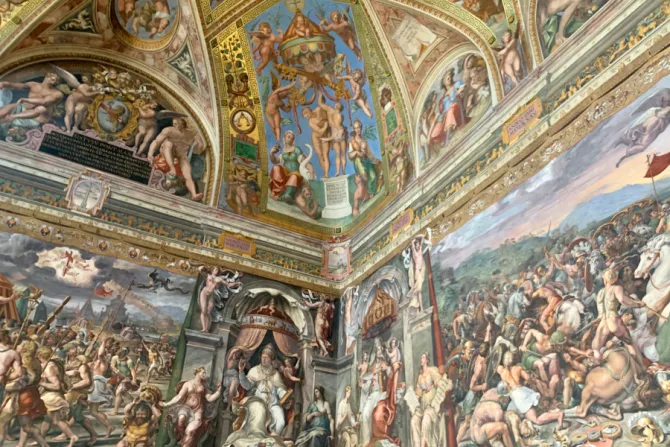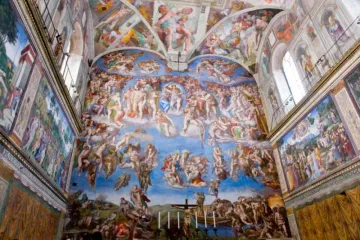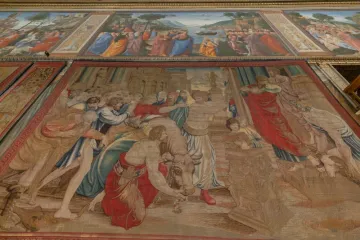Vatican City, Jun 2, 2020 / 02:01 am
The Vatican Museums reopened Monday revealing newly restored frescoes in the Raphael Rooms depicting scenes from early Church history to the public.
"Today is a way that we can in some way share [beauty] with the entire world ... thanks to Raphael," Vatican Museums Director Barbara Jatta told CNA June 1.
"It is a joy, and it is, of course, a part of our work, but after the lockdown -- after the pandemia -- it is more a joy," Jatta said.
After being closed for three months due to Italy's coronavirus outbreak, the Vatican Museums opened their doors June 1 allowing only 1,600 visitors -- under 10% of its usual tourist traffic -- to enter the museums, with additional safety measures.
These visitors to the museums were some of the first to see the restoration of two paintings that art historians believe to be the last works of Raphael, the Renaissance painter responsible for "The School of Athens" and "The Transfiguration."
During the five year restoration process of the 16th century frescoes in the Hall of Constantine, the largest and most recent of the four Raphael Rooms in the Vatican, technical and scientific analysis revealed that two figures in the scenes were distinct in their brushstrokes and technique.
Guido Cornini, the scientific director of restoration of 15th and 16th century works for the Vatican Museums, confirmed that two female figures in the scene, allegorical figures for justice and friendship, were painted by Raphael's hand.
Raphael was instrumental in forming the conceptual sketches of the Hall of Constantine, but he died before their completion. The artists in his studio continued the work after his death, mostly notably Giulio Romano.
The Hall of Constantine provides a visual history of the Church in the fourth century.
Its four walls depict scenes from the life of Constantine, who issued the edict that legalized Christianity throughout the Roman Empire in AD 313. The room contains frescoes of Constantine's vision of the cross, the Battle of Milvian Bridge, his baptism in the Archbasilica of Saint John Lateran, and the alleged Donation of Constantine in the old St. Peter's Basilica.
Flanking these scenes are paintings of canonized popes, including St. Peter, St. Sylvester, St. Gregory the Great, St. Damasus, St. Urban, and St. Clement.
Surrounding the popes are allegorical female figures of representing virtues, such as fortitude, innocence, prudence, friendship, justice, honesty, and peace.
Constantine's Vision of the Cross
St. Peter depicted to the left of Constantine's vision of the cross.
Raphael was commissioned to paint the hall in 1517, which was to serve as a state room where Leo X would receive his formal audiences.
(Story continues below)
Some scholars believe that the throne of the pope sat directly beneath the painting of Constantine's vision of the cross between the images of St. Peter and St. Clement, whose likeness was based on Leo X's face.
The Vision of the Cross fresco depicts a key event said to have been a step towards Constantine's conversion to Christianity. The fresco depicts the emperor in a military camp looking toward a giant cross in the sky that is surrounded by Greek words saying, "In this sign, conquer."
The images are based on the fourth century historian Eusebius' "Life of Constantine" with a notable exception: Raphael chose to paint Constantine's vision of the cross as taking place on the Vatican hill.
The Battle of Milvian Bridge
The largest fresco in the room shows Constantine's battle at the Milvian bridge with his brother-in-law Maxentius, a rival imperial claimant.
In the scene, Constantine is victorious. He rides triumphantly on his white horse leading the banners topped with crosses, while Maxentius drowns in Rome's Tiber River.
Raphael sketched the concept for this scene, along with Constantine's Vision of the Cross. However, according to art historian Philipp Fehl, Raphael originally intended the wall which became the Donation of Constantine to be a different scene depicting Constantine's vision of Ss. Peter and Paul instructing him to seek St. Sylvestor to cure his leprosy.
The Baptism of Constantine
At the end of his life, Constantine was baptized by St. Sylvester. Romano and the other artists in Raphael's studio painted the baptism as taking place in the Baptistery of the Archbasilica of Saint John Lateran. Pope Sylvester is painted with the likeness of Clement VII, who was pope at the time of the Hall of Constantine's completion.
The panel below the Baptism of Constantine depicts the 16th century construction of what we now know as St. Peter's Basilica.
The Donation of Constantine
"It is not finished yet," the director of the Vatican Museums told CNA.
The restoration of the four Raphael Rooms in the Vatican, a project that began in the 1980s, is still in progress. Only one wall in the Hall of Constantine, the last room of the Raphael Rooms to be restored, remains.
Jatta said that the scaffolds should go up in July to begin the restoration on the north wall, which contains a fresco of the Donation of Constantine depicted as taking place inside of the old St. Peter's Basilica, which was demolished in 1505.
Once restored, this 16th-century fresco will provide an even clearer eyewitness representation of the old basilica for modern viewers who wish to see how the original altar was placed over the tomb of St. Peter.
The Donation of Constantine refers to a document, now recognized to be a medieval forgery, which recorded Constantine as granting temporal power over Rome and the western part of the Roman Empire to Sylvester I and his successors.
The unveiling of the restoration of three of the Hall of Constantine's walls coincides with this year's 500th anniversary of Raphael's death.
"We were supposed to open and unveil this important restoration project on the 20th of April in an international conference on Raphael, but this was impossible," Jatta said.
Restoration of the Raphael Rooms was suspended during Italy's lockdown; however, the restoration artists were able to continue their work in May before the museums' reopening.
The museum director expressed her gratitude to the American philanthropists, the Patrons of the Arts of the Vatican Museums, who funded the five year restoration project.
Raphael's other famed works, including the Transfiguration, Madonna of Foligno, and the School of Athens, can also be viewed in the Vatican Museums.






